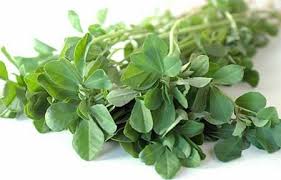The following page describes everything about Fenugreek vegetable. It tells what is Fenugreek meaning, and what do we call Fenugreek in Hindi. Some hidden facts also like the health benefits of Fenugreek dry vegetable and much more. This page describes facts about Fenugreek. It tells Value of Fenugreek vegetable including Minerals and Vitamins in Fenugreek vegetable and describes what are the natural benefits and curative properties of Fenugreek with Health Benefits of Fenugreek.
Fenugreek
Botanical Name/Scientific Name : Trigonella foenum-graecum
Indian Name: Methi
Description of Fenugreek Vegetable
Following is the Description of Fenugreek Vegetable. It includes Fenugreek color and some more information about Fenugreek–
Fenugreek is a well-known leafy vegetable. It has excellent medicinal virtues. It is Nature’s great boon to mankind and its regular Arse will help keep the body healthy. Fenugreek is an erect, strongly scented, robust, annual herb, about 30 to 60 cm. high. It has compound leaves of light green colour 2 to 2.5 cm. long, auxiliary yellow flowers, and thin pointed pods, 5 to 7 cm. tong. The seeds are brownish-yellow and emit peculiar odour. There are two popular varieties of fenugreek known as Masuri Methi or Champa Methi and Marwari Methi. Both the varieties are scented and are recommended for cultivation.
Origin and Distribution of Fenugreek Vegetable
The Following paragraph describes the origin and distribution of the Fenugreek Vegetable. Go through to know more about the origin and distribution of the Fenugreek Vegetable–
Fenugreek-is considered being a native of eastern Europe and Ethiopia. It is also found growing wild in north-western India. It has been used since ancient times both as a food and medicine by the people living on the shores of the Mediterranean and in Asia. The fenugreek is a cool-season crop and it grows all over India. Food Value In India, the plants and leaves of fenugreek known as methi-ka-saag are commonly used as culinary vegetables. Steaming is considered the best method of cooking leaves as in this process the vitamins are retained and the vegetable is palatable. The dried leaves can be compared to pulses for their protein content. They supplement lysine-deficient cereal diets. Lysine is an amino acid which is fundamental constituents of all proteins. The seeds of fenugreek contain a foetid and bitter fatty oil resin, mucilage and albumin. Their mineral and vitamin contents are very high. In Indian homes, seeds are generally used as a condiment and for flavouring.
Value of Fenugreek Vegetable
Fenugreek nutrition is another matter of knowledge. So here we are providing Fenugreek nutritional value which actually tell about Fenugreek nutrients and their benefits.
Fenugreek Food Value
Moisture in Fenugreek 86.1%
Protein in Fenugreek 4.4%
Fat in Fenugreek 0.9%
Minerals in Fenugreek 1.5%
Fibre in Fenugreek 1.1%
Carbohydrates in Fenugreek 6.0%
100%
Minerals and Vitamins in Fenugreek
Find details about Minerals and Vitamins in Fenugreek. It specially focuses on Fenugreek Nutrition–
Minerals and Vitamins in Fenugreek Vegetable
Calcium in Fenugreek 395 mg
Phosphorus in Fenugreek 51 mg
Iron in Fenugreek 16.5 mg
Vitamin C in Fenugreek 52 mg
Small amount of Vitamin B Complex
Value per 100 gms edible portion
Calorific Value – 49
Natural Benefits and Curative Properties of Fenugreek
Fenugreek has a lot of curative properties and natural benefits. Read this passage to find benefits of Fenugreek–
The leaves of fenugreek arc aromatic, cooling and mild aperent. A paste of the fresh leaves applied over the scalp regularly, before taking bath, lengthens hair, preserves the natural colour and keeps the hair silky soft. A paste of the fresh leaves, applied on the face every night before going to bed and washed with warm water, prevents pimples, blackheads, dryness of the face and early appearance of wrinkles. It improves complexion and makes one look years younger. The seeds of fenugreek are demulcent, diuretic, carminative which relieves gastric discomforts, lactagogue, which increases the flow of milk, astringent and aphrodisiac tonic.’ They are the best cleansers to the body, highly mucus-solvents and soothing agents. The seeds are used in the preparation of hair tonics and cosmetics in Java.
Fenugreek has wonderful health benefits in Treatment of Digestive Disorders, Anaemia, Pregnancy and Lactation, Deadened Sense of Task and Smell, Dandruff, Fevers, Stomach Disorders, Respiratory Infections, Sore Throat, Bad breath and Body Odour, Diabetes, Swellings. To read more about them click the link below-
Click Here for Amazing Health Benefits and Curative Properties of Fenugreek

